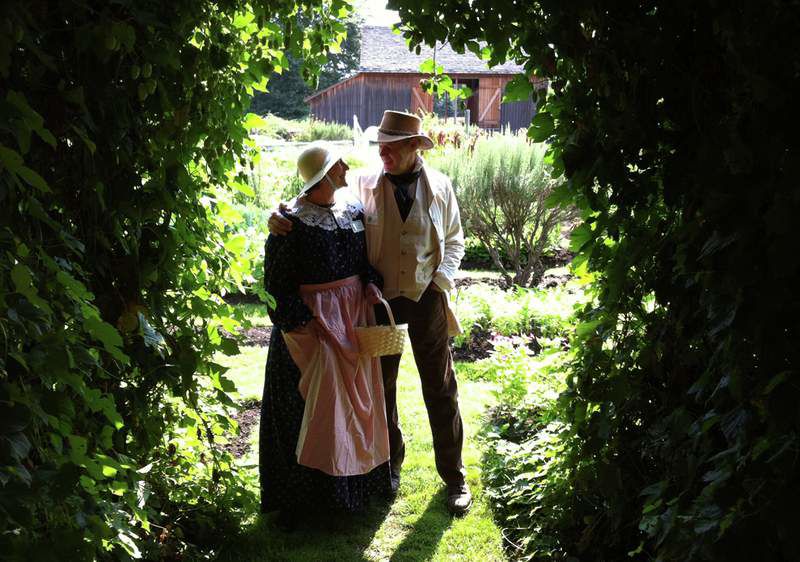Heritage area soaked in history
Published 5:00 am Monday, September 24, 2012

- Monument Plaza, shown here at the Champoeg State Heritage Area near St. Paul, is the site of the 1843 vote that created a provisional government — the first government established in the Pacific Northwest.
ST. PAUL — If you’re exploring Champoeg State Heritage Area for the first time, a good starting point is Monument Plaza on the northwest side of the park.
The granite monument marks the spot where a vote was taken May 2, 1843, to form the first provisional government in the Pacific Northwest.
The vote, coming 16 years before Oregon became a state, was a squeaker. Fifty-two men voted in favor of the provisional government. Fifty opposed it. The names of the 52 are inscribed on the monument, erected in 1901.
On a balmy Friday evening in August, my wife Nancy and I rode our bikes from our A Loop campsite on the east side of the park to Monument Plaza. We looked around the adjacent Pioneer Memorial Building, erected in 1918. The building served as Champoeg’s visitor’s center until 1977.
Another thing you’ll learn about at Champoeg is the great flood. To me, the great flood was in February 1996, but that one didn’t come close to the flood of 1861 that wiped out the town of Champoeg. On the north side of the Pioneer Memorial Building below one of the second-floor windows is a marker indicating the height of the 1861 flood. It was 55 feet above the summer stage of the river, and considerably higher than the flood of 1996.
Champoeg has healed from all the floods. As dusk approached, we took the forested dirt trails along a tranquil Willamette River near the memorial building and monument.
Besides the 1 1/2 miles of river trails, Champoeg has a four-mile asphalt path for bicyclists and hikers that goes from a parking area on the west side of the park four miles east through the park and on to the town of Butteville.
From the B Loop campground to Butteville, you get a scenic ride — or walk — along the Willamette. The rewards at the Butteville end of the trail are sandwiches, pie, ice cream, soft drinks, beer or coffee at the Historic Butteville Store, which dates back to 1863.
Owned by Oregon State Parks and operated by the Friends of Historic Champoeg, it is the oldest continuously operating store in Oregon. You’ll also find a reading room, a large checkers board and a chess board.
If you don’t have lunch there, I’d recommend that you at least order a rocky road cone.
The store is open Thursday through Sunday until November.
During our three days at Champoeg, I never saw the popular disc golf course in the Oak Grove day-use area without at least a handful of players, mostly guys between the ages of about 25 and 45.
One of them was Dale Kimball of Tualatin who was playing with a group from his church.
“It’s a good place,” said Kimball. “It has a variety of trees and open space.”
Just north of the Oak Grove is Champoeg’s 200-foot concrete boat dock.
While a family from Carlton launched kayaks in the early afternoon, 17-year-old Jason Reedy, a West Linn High School senior, fished a few yards away as his mom, Jennie Reedy, soaked up the sun.
Jason, using salmon eggs and corn soaked in gelatin, hadn’t had any luck but seemed to be enjoying the laid-back afternoon.
Champoeg is a great place for anyone who loves nature.
Besides an abundance of white oaks and fir trees along the river, the park has a restored wet prairie (wet until summer) and a variety of plant and bird species. The upland or dry prairie is currently being restored.
On the third Saturday in June, the park celebrates the return of Western bluebirds to the park.
Located among farms in the fertile Willamette Valley, Champoeg was established as a park in 1913 to commemorate the 1843 meeting to form a provisional government. The park gets its name from “Champooick,” an American Indian village once located there.
You can’t come away from Champoeg without getting a history lesson or history being unearthed.
Before the 1840s, the Champoeg prairie was home to Kalapuya Indians, who used the area for hunting, fishing and gathering camas roots.
Fur trappers started arriving in 1811, followed by settlers in the 1830s and ’40s.
In recent years, Oregon State University has offered archaeology classes in which digs by students have produced 19th century artifacts and unearthed a cabin site in the east side of the park.
The volunteer group Friends of Historic Champoeg provide education and interpretive programs.
During a walk through of the visitors center’s historic displays, I met two costumed interpreters, Dave and Susi Gordon, of Canby. Both are retired teachers.
They come to the park twice a month to answer questions and play the role of a 19th century Champoeg couple.
“It’s a wonderful place to be,” Susi said. “You learn so much history here.”





